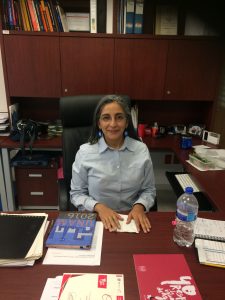27 December 2017–Xyoli Pérez-Campos was 11 years old when the magnitude 8.0 Michoacán earthquake struck the Mexico City region on 19 September 1985, collapsing buildings near her home. Her uncle survived the total collapse of the 13-story Nuevo León apartment building, in an area of the city devastated by the quake. “All of this triggered curiosity on the [earthquake] phenomenon,” Pérez-Campos recalled. “Later, when I was 14, my mom took me to a career fair and to visit the National Seismological Service. I knew then I wanted to be a seismologist.”
Exactly 32 years later, on 19 September 2017, a magnitude 7.1 earthquake hit central Mexico and Mexico City again, following on the heels of the magnitude 8.2 Chiapas earthquake on 7 September. Pérez-Campos is now the head of the Servicio Sismológico Nacional (SSN), the Mexican national seismological service, and she and her colleagues are working on massive research and outreach efforts after the September events—even as some of them are recovering from the earthquake’s immediate impacts.

“At least one SSN station was damaged, and the seismometer had to be changed,” Pérez-Campos explained. “Some of our homes were damaged and will require some retrofit. Buildings near some of our homes were either badly damaged or collapsed. Once again, a block away from my house, an apartment building collapsed and nearby a supermarket also collapsed.”
“My house had already a crack that got a little bit worse with the earthquake. I definitely need to retrofit my house,” she added. “Some of the houses and apartments that got damaged are from some of the technical staff at the National Seismological Service.”
At the national service, research switched priorities after the 19 September earthquake, Pérez-Campos said. At first, she was handling media interviews—“the activity was intense for about a month,” she said. Then she and the SSN scientists turned their attention to meetings and proposals to improve the national seismic network and increase the budget for network maintenance.
Much of Pérez-Campos’ time is spent coordinating activities and looking for funding for the SSN. She also teaches an undergraduate class and advises undergraduate and graduate students at Universidad Nacional Autónoma de México (UNAM). One of her main research interests lies in analyzing seismic energy and how it can be related to other important aspects of the seismic source, and to identify seismic factors related to tsunami early warning and damage potential.
“For seismic structure, I am focused on delineating the geometry of the Cocos plate, and on characterizing the mantle transition zone and how the subducted plate interacts with it,” she said. (The Cocos plate is an oceanic tectonic plate that dives below the North American Plate and was likely involved in the recent Chiapas earthquake.)
Her dream project “is to have a MexArray, similar to US Array, that allows us to map and understand all our country,” she said, referring the 15-year program to place a dense network of permanent and portable seismographs across the continental United States. “There are some areas where we don’t have data, so little is known.”
Pérez-Campos is also looking into funding and planning strategies to establish an organization similar to Incorporated Research Institutions for Seismology (IRIS) for Mexican earthquake research institutions.
The Mexican seismic networks “might not be as impressive in numbers as in the U.S., but they produce good quality data, and they can be the backbone for other regional or local-focused projects,” she said. “Also, we have good research groups. There are many good old papers on current hot topics that are sometimes missed by researchers outside the region because they have been published in local or regional journals” such as Geofísica Internacional, she noted.
In the period after the September earthquakes, Pérez-Campos spoke to a variety of audiences, including high school and university students, the media, policymakers, civil protection officials and the general public. “The focus of the talks has been the earthquakes themselves, how they happened and why they were so intense–or not, for the 7 September quake– in Mexico City,” she said. “I explain that Mexico is an earthquake-prone country and since earthquakes cannot be predicted, we always need to be prepared. I go over misconceptions and myths that are very typical in Mexico and try to explain the right concepts; for example, people use magnitude and intensity as synonyms.” (The USGS site contains a short explanation of the difference, as does the SSN in Spanish.)
“The biggest challenge is to keep the interest on the topic, so authorities and people keep themselves informed about earthquakes in Mexico, and this leads to better preparation,” said Pérez-Campos. “Also, I look for all types of projects that help improve not only seismic monitoring but also education and outreach on earthquake seismology.”
